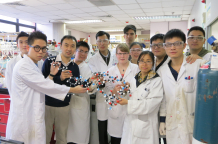Media
HKU chemists successfully synthesize structurally complicated antibacterial drug Daptomycin which bring hopes for the development of new antibacterial drugs
25 Apr 2013
A group of researchers led by Dr Xuechen Li of the Department of Chemistry, the University of Hong Kong, have invented a method to stitch peptides together to form proteins in a highly efficient manner, of which the findings have just been published in an internationally leading journal - Proceedings of the National Academy of Sciences of the United States of America (online version). By using this method, the team, for the first time, chemically synthesized an antibacterial drug called daptomycin in their laboratory. The result is now on another renowned journal, Journal of The American Chemical Society (online version). Their achievement will bring hopes for the development of new antibacterial drugs.
 Dr Li Xuenchen (second from the left in the first row), Assistant Professor of HKU Chemistry Department and his research team
Dr Li Xuenchen (second from the left in the first row), Assistant Professor of HKU Chemistry Department and his research team
Bacterial infections used to plague mankind. Thanks to the emergence of antibacterial drugs, as antibiotics, bacterial infections become easily curable. However, bacteria can rapidly evolve to become resistant to the drug after treatment. Once an antibiotic enters widespread human therapeutic use, its effective life span becomes limited. Therefore, in the war against bacterial diseases, we are in danger of lacking antibiotics to treat bacterial infections, since the rate of increase of bacterial resistance is extremely high, as exemplified by the emergence of “super-bug” bacteria, which cannot be killed by any antibacterial drugs in the current market. Thus, the battle between the bacterial resistance and development of new drugs will never stop.
The HKU research team led by Dr is aiming to develop new antibacterial drugs. Over the past three years, they have been searching for methods to synthesize daptomycin molecule. Daptomycin was isolated from the soil Streptomyces roseosporus, and then developed into a new antibacterial drug in 2003 (which is applied in curing skin infection). It is considered to be a drug of last resort. However, we have to face the fact that development of drug resistance to daptomycin in pathogenic bacteria is just the matter of time. Many researchers, including Dr Li’s team, are working on daptomycin derivatives as daptomycin-based next-generation antibiotics for additional clinical applications and in preparation for future waves of the development of bacterial resistance. Because daptomycin is currently produced by fermentation, people cannot readily modify its structure. To overcome this problem, the HKU research team is taking a chemical approach to prepare daptomycin analogues. Daptomycin is a structurally complex cyclic peptide, presenting hurdles for chemical synthesis. In particular, the difficult formation of the head-to-tail ring has challenged chemist’s efforts for its synthesis. After three years’ efforts, Dr Li’s team have finally made a breakthrough, in which their newly discovered method for stitching peptides makes the ring formation possible. Now they have developed an efficient strategy allowing them to chemically synthesize and modify the daptomycin molecule very easily.
With the capability to modify daptomycin molecule in hand now, HKU researchers take steps forwards and they are planning to prepare dozens of daptomycin analogues aiming to search for daptomycin-based next-generation antibiotics. They expect that they will be able to develop new antibacterial drugs in the next few years.
For more information about researches at the HKU Faculty of Science, please visit:
http://www.scifac.hku.hk/news/media?page=1
For press enquiry and arrangement of interviews, please contact Ms Cindy Chan, Communication Manager of Faculty of Science, at 2241 5286/ 6703 0212 or by email at cindycst@hku.hk
Dr Li Xuechen and His Team
Dr Li Xuenchen is the Assistant Professor of the Department of Chemistry of The University of Hong Kong. After his PhD education at Harvard University and Post-doctoral training at Memorial Sloan Kettering Cancer Center in New York, Dr. Li moved to HKU and teamed up a group of talents with a research focus on chemical biology and medicinal chemistry in 2009.
Two Papers
“Protein Chemical Synthesis by Serine and Threonine Ligation”
at Proceedings of the National Academy of Sciences of the United States of America: http://www.pnas.org/content/early/2013/04/04/1221012110.full.pdf+html
Proceedings of the National Academy of Sciences of the United States of America, referred to as PNAS, is the official journal of the United States National Academy Sciences. PNAS is an important scientific journal with coverage broadly spanning the biological, physical and social science.
“Total Synthesis of Daptomycin by Cyclization via a Chemoselective Serine Ligation”
at Journal of The American Chemical Society: http://pubs.acs.org/doi/abs/10.1021/ja4012468
Journal of the American Chemical Society, established by the American Chemical Society, is the most cited journal in chemistry field.
Antibiotics and Bacterial Resistance
Ever since the discovery of the first antibiotic, penicillin, in 1928, bacterial infections that used to kill millions of lives became curable. However, bacteria can rapidly develop mutations and become resistant to antibiotics after treatment, and can pass genes for multiple drug resistance between strains and even between species. Once an antibiotic enters widespread human therapeutic use, its effective life span becomes limited. The battle between the bacterial resistance and development of new drugs will never stop. For instance, over the past decades many penicillin-based antibiotics have been developed and brought into the market, including benzylpenicillin, ampicillin, flucloxacillin, dicloxacillin, methicillin, carbenicillin, ticarcillin, piperacillin, and more. Indeed, the current drug development programs appear insufficient to provide therapeutic coverage in the foreseeable future. Methicillin–resistant Staphylococcus aureus (MRSA) has emerged as one of the most important pathogens, both in hospital and community-acquired infections. It is considered as one of the most important super-bugs in Hong Kong and caused huge mobility and mortality. Recently, Gram-negative organisms (super-bug) which have become resistant to all classes of antimicrobials have been discovered in India, the UK and Pakistan and soon spread around the world. The increasing incidence of multidrug-resistant bacterial infections threatens to take medicine back into the pre-antibiotic era since the mortality of these so-called “superbugs” are high and the choices of treatment are extremely limited.
